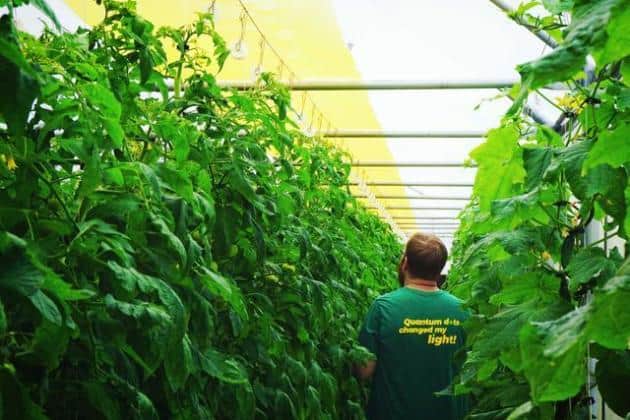2021
UbiGro Film Enhances Cannabis Yield with Spectral Mod
2020
Nanotech & Luminescent Films Boost Greenhouse Quality
From Farm to Table: Quantum Dots that Do It All
Q&A: Nanosys, UbiQD Bring Quantum Dots to Agriculture
Greenhouse Technology Boosts Crop Yields Up To 20%
Layer Of Light Helps Plants Get More From The Sun
Quantum Dot Tech Boosts Yields & Energy with UbiQD
Hello Tomorrow Deep Tech Finalist
Cannabis Today Podcast – Steve Blank
2019
Efficient Colors Boost Crop Growth and Biomass
NASA Awards UbiQD Larger Contract for Space Crop Yields
Harvesting Of Red Light Accelerates Plant Growth
Frost & Sullivan Best Practice Award
Technological Advances Help Optimize Greenhouse Sunlight
UbiQD Wins 2019 SXSW Pitch in Hyper-Connected Category
10 Killer Agricultural Technologies
Greenhouse Technology Boosts Crop Yields Up To 20%

Copyright © 2020 Albuquerque Journal
California-based Nanosys Inc. will apply its manufacturing capabilities to help Los Alamos startup UbiQD Inc. ramp up production of its quantum dot-based film for greenhouses.
Nanosys operates the world’s largest quantum dot factory in Silicon Valley, where it produces film coverings for the global display industry, such as ultra-high definition TVs.
Quantum dots, a cutting-edge technology at the heart of UbiQD’s film, offer unique properties that make them valuable in various applications. But what is quantum dot technology? Quantum dots are nanoscale semiconductor particles that exhibit quantum mechanical properties. In simpler terms, they are tiny, light-emitting particles with size-dependent optical and electronic properties. These properties make quantum dots ideal for applications ranging from electronics to medical imaging.
UbiQD, or Ubiquitous Quantum Dots, has developed a window film for greenhouses that accelerates plant growth and increases crop yields by bending sunshine to emit red light, which plants crave for optimal growth.
That’s a completely new application for quantum dots, which are tiny, three dimensional structures that manipulate light in unique ways. They’re currently used in everything from transistors and sunscreen to LCD televisions, tablets and smart phones.
Nanosys already dominates that industry. But now, through a new partnership announced May 20, the company will open its manufacturing operations to mass produce quantum dots for “UbiGro®,” the new greenhouse film that UbiQD began marketing in 2018, said UbiQD founder and CEO Hunter McDaniel.
“This partnership makes a lot of sense for both companies,” McDaniel told the Journal. “Nanosys is the global leader in quantum dot manufacturing for the display industry, and we’re a small, early-stage company with a new type of product. We can rapidly scale up by leveraging Nanosys’ production capability, while offering them new markets for quantum dots.”
Since Nanosys launched in 2001, the consumer electronics industry has used its quantum dots in some 20 million electronic devices, according to the company. But the greenhouse market offers an even larger outlet for the technology, with potential worldwide demand for about 50 billion square feet of UbiGro, said Nanosys CEO Jason Hartlove.
“Greenhouses represent a massive opportunity for the unique benefits of quantum dot technology,” Hartlove said in a statement. “We look forward to working with UbiQD to bring UbiGro to market with our industry-leading scale, cost-effectiveness and highest quality manufacturing standards.”
UbiQD launched in 2014 with a new, low-cost, nontoxic process for making quantum dots that it licensed from Los Alamos National Laboratory and the Massachusetts Institute of Technology. The company began by developing a quantum-dot-based window coating that captures sunlight and then channels the photons to photovoltaic cells on window frames, potentially turning everyday windows into solar electric generators.
But while exploring window coating generation for greenhouses, the company realized it could help growers improve plant productivity and quality by placing quantum-dot film above plants to shift sunshine into a red-light emitting spectrum that mimics late-summer sun. That’s considered the most potent time of year for plants, because they sense winter coming and grow faster.
UbiGro increases yields by between 5% and 20% depending on the crop being grown, McDaniel said.
Share:











